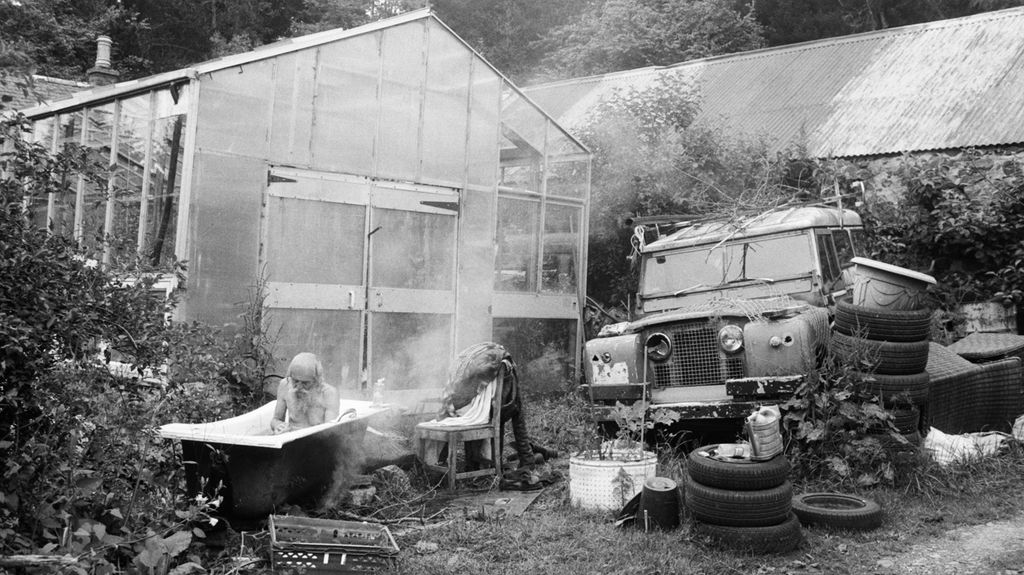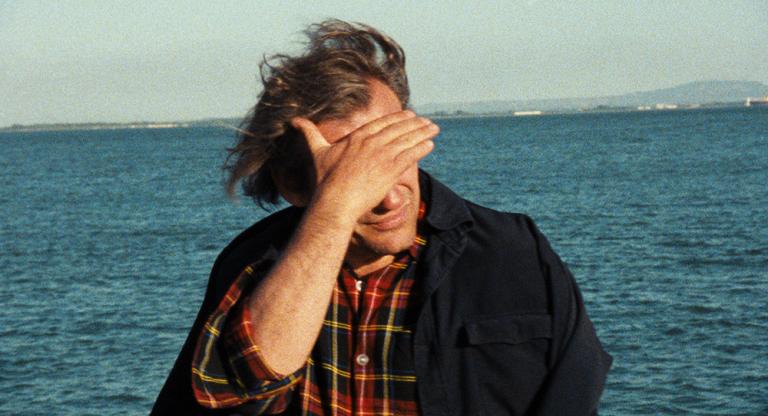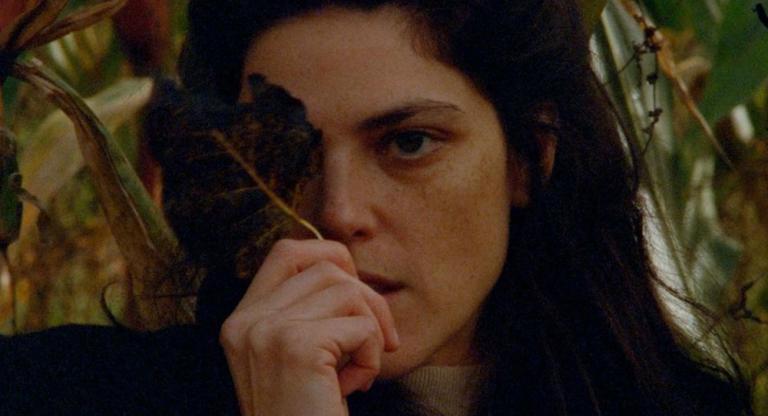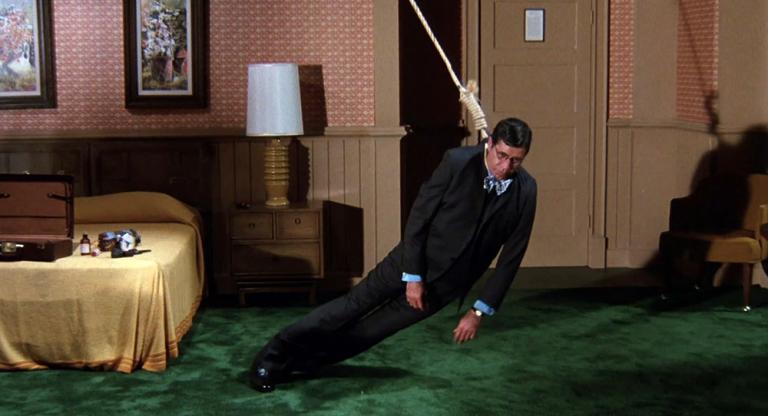Our dispatch on the 2024 Locarno Film Festival comes courtesy of Emerson Goo, Öykü Sofuoğlu, and Nicolas Pedrero-Setzer, who weave their way through the festival and offer their thoughts on counter-images, the docu-fiction craze, and the state of short films.
Emerson Goo
In Harun Farocki’s first film, Two Paths (1966), the camera pans across a poster illustrating two divergent roads: one leading to heaven, the other to hell. Those on the road to heaven pass by a church and a school, helping those in need. The road to hell is lined with brothels and bars; people brawl in the street. Farocki analyzes the image’s binaristic motifs in a rhyming voice-over, underscoring its use as an educational tool for children.
Nora M. Alter, author of Harun Farocki: Forms of Intelligence (2024), played a clip from Two Paths to open a public discussion with fellow media theorist Doreen Mende and artist-researcher Susan Schuppli, known for her work with Forensic Architecture. It was part of Locarno’s “The Future of Survival” conference, which ran parallel to the festival and explored cinema’s relationship to new technologies, as well as issues of social and environmental sustainability. For Alter, Farocki’s oeuvre was an invitation to listen to images by performing a close reading that unsticks them from the ideologies and forms of control in which they are embedded—mass media, schooling, religion. Beyond merely looking, to listen to an image requires asking what it wants us to do and believe in, so that we can respond consciously—perhaps with our own counter-image—and find our own path through it.
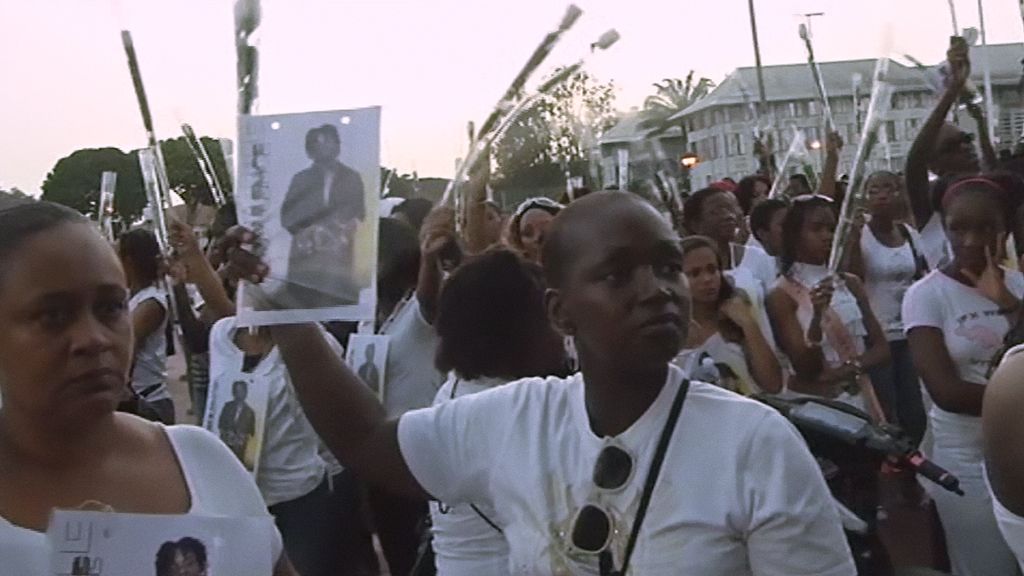
I’d like to stay with this idea of listening as a cinematic practice, as some of Locarno’s best films were those that took Farocki’s invitation seriously, setting their own images against those which dominate society. Maxime Jean-Baptiste’s debut feature Listen to the Voices (2024) makes this objective clear in its title. In his previous shorts, Jean-Baptiste has rigorously critiqued how his home, French Guiana, has been distorted by French films that exploit it as a tropical backlot, and its people as exoticized extras. These misrepresentations are a form of violence, inextricable from that of colonialism and underdevelopment. French Guiana has a reputation as a notoriously unsafe place for its youth, and Listen to the Voices uses a real-life tragedy—the 2012 murder of a teenager, Lucas Diomar—to construct a docu-fictional narrative about its effects on Lucas’s family, which happens to be Jean-Baptiste’s own.
Lucas’s nephew, Melrick, lives in Paris. When he visits his grandma, Nicole, in French Guiana over summer break, her neighbors say he resembles Lucas, whose face looms everywhere—in street art, on a poster in Nicole’s home. Lucas’s image and the landscape of French Guiana envelop Melrick in reverberations of trauma and gestures of remembrance. Breezy scenes capture the vibes of a youthful school vacation; Melrick plays soccer and rides his bike with the local kids, who fantasize about being president of an independent Guiana. He is also learning to play the drums with Mayouri Tchô Nèg, a percussion ensemble that Lucas was part of, in a concert honoring his memory. Contrasting Melrick’s playfulness is the reserved demeanor of Lucas’s best friend, Yannick, who was with him the night he was killed. He is a pained man, who still can't get over what happened. In contrast to Nicole, who has forgiven Lucas’s killers, Yannick seeks revenge. The film embraces both of their perspectives without judgment.
Listen to the Voices is a rare depiction of French Guiana as a real place, not an imagined “green hell.” But the film understands that confronting the violence of misrepresentation isn’t just a matter of transmitting an authentic presence on-screen, it involves attending equally to absence, and to the profound grief that transforms the moments of joy, tenderness, and celebration it shares with us into reminders of those who aren’t here to experience them—without needing to directly state this. It's in the beat of the drums.
When Melrick plays with the rest of the ensemble, taking Lucas’s place, we are listening to a film that evokes the memory of the dead to process not only a personal loss, but also the loss of a cinematic heritage—of the right to represent one’s self—that was stolen from French Guiana. And we also witness the collective power in writing a new chapter for it.
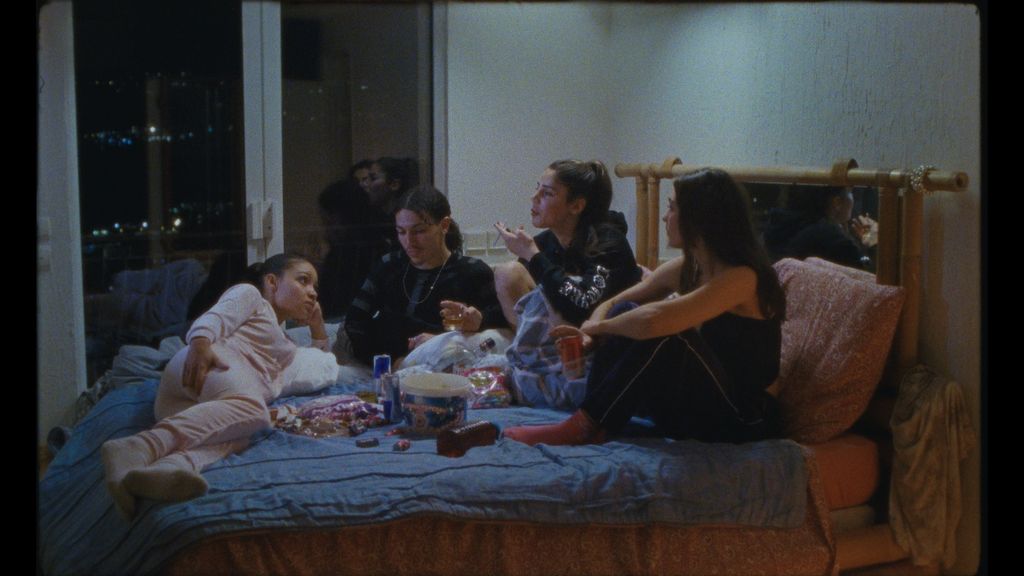
Virgil Vernier’s 100,000,000,000,000 (2024), like Farocki’s The Creators of Shopping Worlds (2001), dives into the construction of images and labyrinths of desire; in this case, the glitzy city-state of Monaco at Christmas-time. Afine (Zakaria Bouti) is an 18-year-old escort who doesn't have it in him to hustle the way his friends, also sex workers, say he should. They dream of starting an escort agency. He wants to take it easy and doesn't know if those are his dreams, too. When he visits Vesna (Mina Gajovic), a Serbian woman in Monaco who is babysitting Julia (Victoire Kong), a pre-teen Chinese girl with wealthy, neglectful parents, he forms a bond with Julia that evades easy description—it is not quite a friendship or a guardianship, but a fleeting dance between two lonely people enjoying the comfort of each other’s loneliness.
Vernier probes the anomie of globalized, liminal spaces designed to expedite the free flow and accumulation of money and ideas—what the economic historian Quinn Slobodian calls the special economic zones of “crack-up capitalism,” in which the ultra-rich carve out new spaces of sovereignty around the world to escape democratic accountability. Monaco is being carved out of the sea and Julia’s parents are leading the massive land reclamation project that never ends (Yeo Siew Hua’s 2018 Golden Leopard winner, A Land Imagined, similarly treated land reclamation as the ne plus ultra of spatial fixes). Julia confides in Afine a secret her parents told her never to share: that they’re also building an island somewhere offshore, a bunker that will protect them from a forthcoming apocalyptic event. Though it’ll never happen, she imagines being spirited away there with Afine, who she wants to live with. There is a storybook logic to 100,000,000,000,000, which takes on the incisive simplicity of a child’s words for this world of consumption and what it means. It reminded me favorably of Shinji Aoyama’s films—Aoi Miyazaki’s premonition about the tidal wave that will obliterate Japan in Eureka (2000), the ragtag crew of drifters at a moving company and the Chinese boy they adopt in Sad Vacation (2007)—and their focus on wayward lives and strange, indefinite relationships.
In The Creators of Shopping Worlds, we learn that the ideal experience of shopping is one where shoppers are monitored and herded down a path made for them without even realizing it. One way that Afine and Julia reclaim Monaco for themselves is by exploring it in discreet, unsanctioned ways. In what was surely one of the most moving and exhilarating sequences at Locarno this year, they enter the bowels of the city, moving through dark underground tunnels, past mechanical systems and ductwork, to emerge on a small, rocky patch of sand fronting a gem-like ocean. There, Afine meets some friends and they smoke together. On this beach, they can pretend that Monaco is theirs, that the world is theirs, that there is a place that can hold them and Julia, and all those who emerge from behind the dominant looks and gazes of society to fashion themselves in their own resistant image.
Öykü Sofuoğlu
The urge to feel a sense of belonging usually intensifies in places where one feels least at home. Our agitated minds plunge into uneasiness, desperately seeking a word, a smell, or a sight that bears even the slightest trace of familiarity. Film festivals, unsurprisingly, excel at providing an overstimulating experience of alienation since the usual protocol at a festival involves watching as many films as possible, from all corners of the world, a feeling akin to that of being dragged through many different places—Ukrainian war zones; European city-streets; dingy sweatshops, as in the case of Wang Bing’s China; the luxurious villas and penthouses of Monaco, as seen through Virgil Vernier's tender and melancholic gaze—at once.
The experience of being virtually in transit while physically stuck in a screening room—the only refuge for sun-struck festivalgoers in a town where the only air-conditioned spaces are cinemas (and not all of them, mind you)—makes one’s body and mind begin to lose their sync. At the Locarno Film Festival, which takes place in a picturesque resort town that primarily appeals to tourists, the knowledge that Locarno quickly reverts into a ghost town once the festival ends only deepens the sense of rootlessness that lingers in one’s head throughout the brief time period when the festival actually takes place. While some festivalgoers may wear their armor thick and come out from the experience unscathed, it is more common to end up being vulnerable with others who also feel rootless and overwhelmed. The entire experience lends itself to oversharing, bonding, and much-need catch-ups with other festivalgoers, even if you’re compelled to cut short blossoming camaraderies due to festival pressures.
Although these emotional outbursts and collisions mostly concern in-person encounters at the festival, they mirror our experiences as audiences seeing real people on the screen, people who were engaged by directors to give us small glimpses of their lives—their joys as much as their pain—first for the camera and then for hundreds of thousands of filmgoers. These people experience an emotional blow-up by consenting to expand the scope through which their existence can be seen, as well as their decision to share a part of themselves that was previously private—they allow random strangers sitting in cozy red seats to search their images for a piece of themselves.
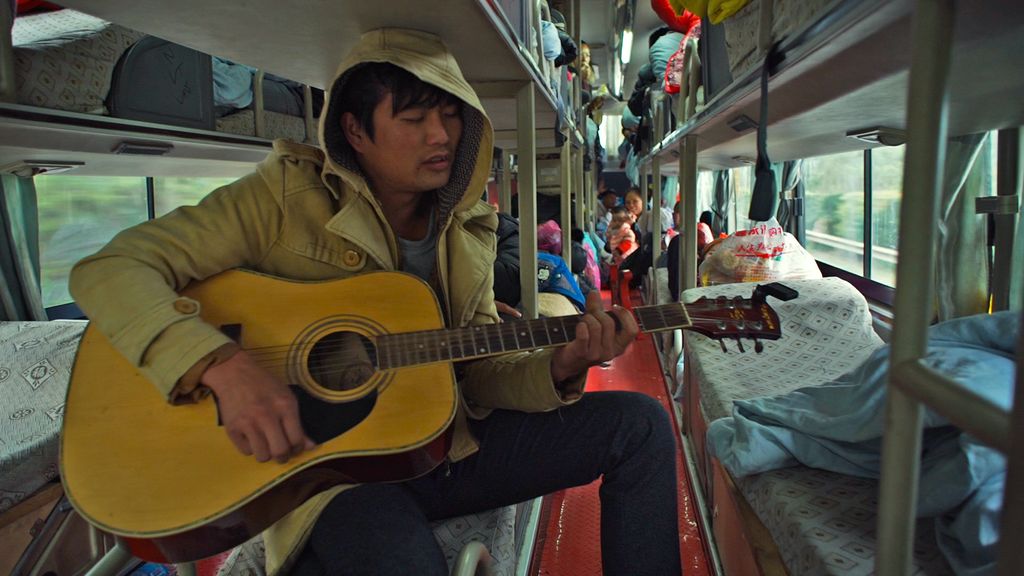
After all, the cinematic medium inevitably creates an illusory and one-sided experience of empathy and compassion from which the audience benefits the most. No matter how ethically sound and well-intentioned a filmmaker may be, there's always a brutal and off-putting aspect to witnessing war, poverty, displacement, and exile at A-list film festivals—grotesque by-products of the culture industries that comply with the logic of the capitalist market. Red carpets are usually what come to people's minds when they think of film festivals, but for those who know how to look deeper, these events operate more like factories where underrepresented identities and world conflicts are commodified, distributed, and consumed.
It is undeniably difficult to watch a Wang Bing film in Locarno knowing that it is very likely the same people seen on the screen are, at that very moment, repeating the exact gestures on a sewing machine, perhaps not in Zhili but somewhere else. Or, that the same machines are operated by different people, as replaceable and indistinguishable to the eyes of their boss as they are to those of the Western audience. Film festivals have never been intended as the final destination for a film, but rather a necessary and vital stop in their trajectory. But, what can an artist, a journalist, or a member of the audience do to help preserve the dignity of on-screen subjects? How can we avoid turning ourselves into culture vultures, hungry for theories, analyses, and metaphors—constantly on alert for the slightest cinematic references that provide us with the self-centered satisfaction of understanding them? This batch of rhetorical questions is as old as the practice of documentary filmmaking itself, but these were the questions that I brought back with me from Locarno, along with reminiscences of a few good films and some soon-to-be-forgotten ones as well.
The artist-and-filmmaker Jessica Sarah Rinland's Collective Monologue (2024), which premiered in the “Cineasti del Presente” competition, had a strikingly similar conceptual focus to my inner musings. Borrowing its title from a concept coined by the Swiss psychologist Jean Piaget, Rinland's film offers a meditative exploration of the fluctuating boundaries between care, surveillance, and power characteristic of modern biopolitics and its implementation within care-based institutions. Throughout the film, Rinland and her 16mm camera travel across zoos and animal care centers in Argentina, mostly following Maca, a caretaker whom Rinland befriended while preparing for the project.
As we explore the different environments provided for numerous species—elephants, howler monkeys, Macaw parrots, tamanduas, and flamingos, to name a few—relics of the not-so-hidden history of systemic violence and racism established by European civilization and its biased scientific methods begin to emerge. Labeled today as “Eco-Parks” and “Bio-Centers,” in an attempt to rebrand them with the ethos of conservation, these places still bear the scars of colonialist and anthropocentric ideologies inflicted upon non-human animals and Indigenous communities.
Yet, as a director, Rinland consciously avoids assuming a position of authority that could have yielded a condemnatory or apologetic relationship to her subjects by maintaining an appropriate distance—not just from the political and ideological questions in Collective Monologue, but also from the film's human and non-human animal subjects. Her gaze operates just as it would when filming a meek tamandua lurking in the dark behind thick bushes: curious yet respectful, waiting to see how her subject will act and react. Words may be powerful, but they belong to an anthropocentric perspective and Collective Monologue is most striking when forms of non-verbal communication and contact prevail over spoken language—hand to claw, skin to fur, eye to eye—where cages, security cameras, and training equipment are momentarily forgotten, and a fleeting yet mutual sense of freedom reigns.
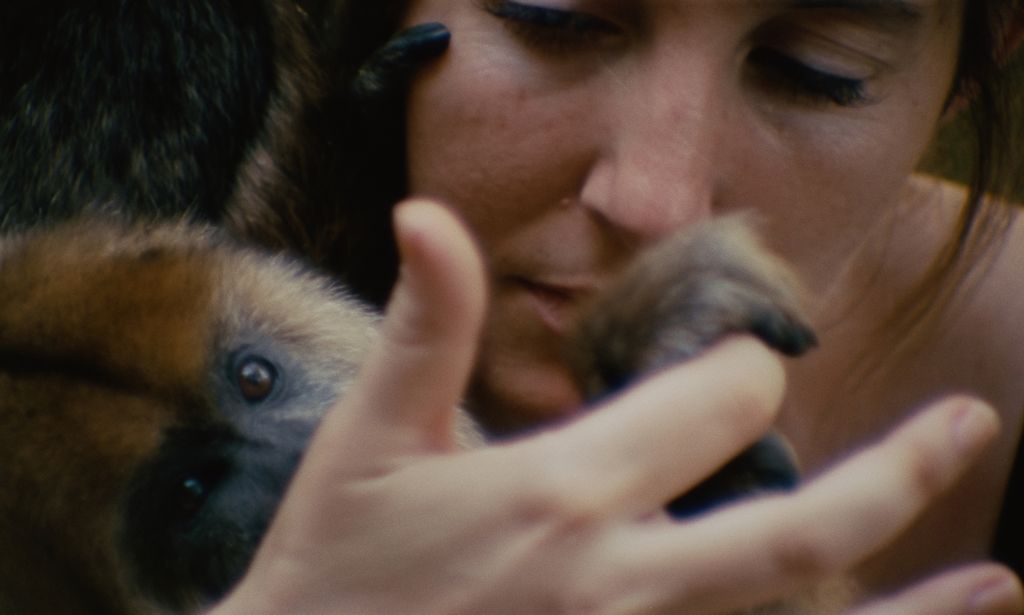
Returning to reality after moments of cinematic exaltation always feels like a hard fall, especially when the viewer's mind tries to drift far beyond the conceptual frame the filmmaker initially set up. Compared to Collective Monologue and its predominantly observational approach, Ben Rivers's Bogancloch (2024, pictured at top) offers a more expansive space for imagination, with a conspicuously performative logic guiding his direction. Conceived as a follow-up of sorts to the filmmaker's first feature, Two Years at Sea (2011), Bogancloch sees Rivers reuniting with his protagonist, Jake Williams, thirteen years later.
Once a sailor, now a full-time hermit living in the Scottish Highlands, Williams met Rivers around 2005, when the latter was interested in filming someone leading an off-grid, solitary existence. Today, with two shorts and two feature films later, it is compelling to observe how Rivers's depiction of Jake Williams has evolved. Rivers, whose initial fascination and curiosity perfectly embodied one of the predominant impulses in traditional nonfiction filmmaking—approaching the other, the stranger—shifts from trying to fit Jake into a preexisting concept, to creating a custom-fit portrayal with him and for him.
What Rivers does in Bogancloch is far different from merely observing a rare and endangered species—though Jake certainly is one—in their natural environment. Rather than striving for transparency or immediacy in representation, Bogancloch explores how the self can be performed through one's gazes, gestures, and actions. Here, observations are raw materials waiting to be processed. As for Jake, everything he does, he does because there is a camera filming him, not in spite of it—regardless of whether some of those actions mirror what he actually does outside the film.
Rivers is also acutely aware of how the technical traits of the formats he uses, such as a Bolex camera and Super 16mm film, influence the way actions unfold over time. The succinct, controlled nature of each action—which Williams and Rivers perform and transform in tandem—provide the audience with a much-needed detachment and awareness of off-screen reality, which would otherwise render our gaze too raw and intrusive. Though the final format screened at the festival was a 2K DCP, Rivers is known for hand-processing his footage, welcoming visual accidents, unexpected grain, and the chemical autonomy of the images he creates. In a time dominated by live cams, CCTV, and various other forms of ubiquitous media that render the concept of mediacy obsolete, it is refreshing to remember that getting to know someone takes time, and that images need time to be made as they journey from the viewfinder to our recollections.
Nicolas Pedrero-Setzer
There’s no way around it. Most of the short films at this year’s edition of the Locarno Film Festival were awful, middling at best. There were two genuine exceptions—Maryam Tafakory’s Razeh-del (2024) and Syeyoung Park’s The Masked Monster (2024)—along with two visually rich, but narratively glib selections—Claire Barnett’s Freak (2024), and Caroline Poggi and Jonathan Vinel’s The Exploding Girl (2024). The rest of the selection, with its hodgepodge of aesthetic experiments and hot button topics, reflected a tired method of curation that subscribes to showing the expected over embracing exploration.
Even though the festival’s shorts selection is framed as representing the future of cinema—it is titled “Pardo di Domani” after all, which translates to “Tomorrow’s Pardo”—and meant to introduce the world to new filmmakers who are just starting out, the feeling that these films are no more than an afterthought at the festival is hard to rub off. Not only are films from three different shorts categories—“Concorso Nazionale,” “Concorso Internazionale,” “Concorso Corti d’Autore”—jumbled together into programs with no unifying theme or overarching sense of direction, but most of the shorts programs take place at the farthest cinemas from the town center: PalaVideo, La Sala, and L'altra Sala. This disregard for the short-form is certainly not particular to Locarno, reflecting an attitude shared across most premier film festivals, one that has sadly contaminated the way most cinephiles think of the form as well. So long as shorts are only thought of as incipient projects, or better-yet, proof-of-concepts for longer, more commercial endeavors—the real films of tomorrow—this problem will persist because neither curators, nor critics, will address short films as artistic works that merit commentary today.
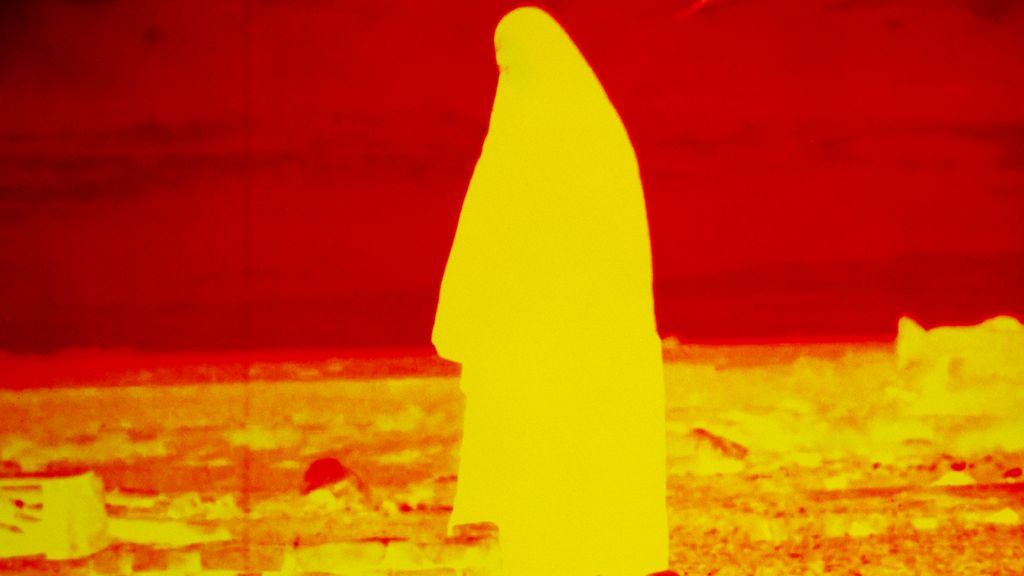
Razeh-del and The Masked Monster are exceptions in this regard because they both commit to the fullness of their respective projects, to political directness and the creative extremes of genre filmmaking. The former is the latest by Tafakory, an Iranian filmmaker and artist whose work often makes use of found materials to retrieve lost histories, particularly those of female resistance in Iran. Razeh-del—perhaps her clearest film in terms of its political agenda, and one of her most visually intricate, and thus exciting works—looks back at the history of Zan, Iran’s first woman’s newspaper.
In what seems like a non-stop informational montage, Tafakory layers images and quotes atop one another, patiently piecing together the story of two high-schoolers discussing Zan—as with most festival coming-of-age films, the teenagers’ story doubles as a political tract. But, while most filmmakers working in this style would either emphasize the distance between their protagonists and the structural issues conditioning their formative years, or flatten them so that their characters lose all sense of personhood by becoming political symbols, Tafakory constantly alternates between these two modes, creating a whirlpool of visual and textual citations that embody the drastic changes and pervasive sense of confusion present in post-revolutionary Iran.
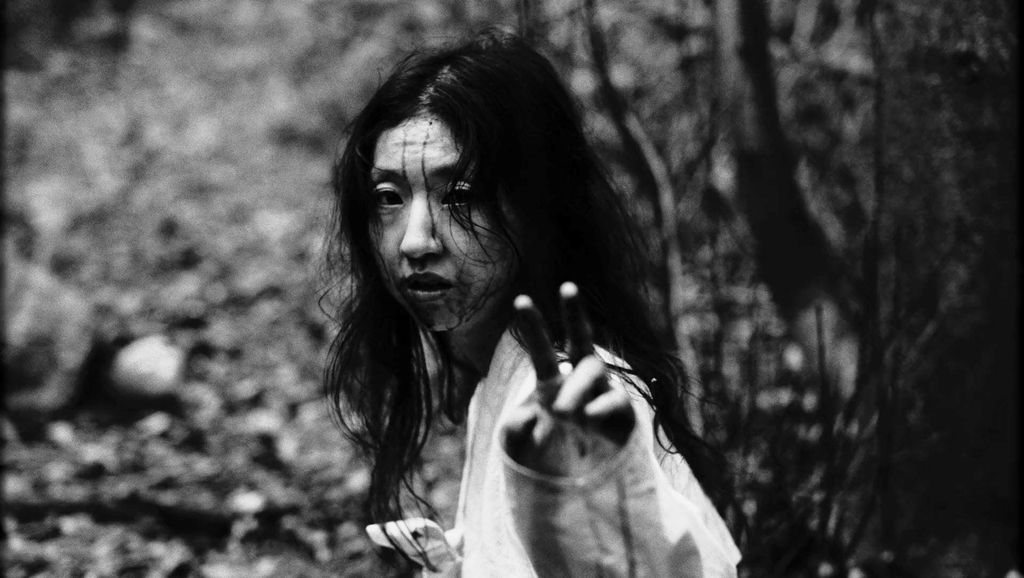
The Masked Monster is a pure exercise in genre filmmaking. Shot in black-and-white and totally wordless, the film’s nightmarish fable about two siblings tricked by a talking crow evokes the likes of Häxan (1922) and A Page of Madness (1926), two early films that deal in hellish visual content and explore local myths. Beyond its compelling visuals, what’s most striking about The Masked Monster is its insistence on the power of brevity. Though fast-paced at 15 minutes, The Masked Monster is not a film that dashes toward its finale; instead, it squeezes every bit of emotion from each second in its runtime. The film attests to the talent of a budding filmmaker who is keenly aware of the materials and limits he’s working with, someone who has a clear grasp on the images he seeks to create and isn’t afraid to entertain his wildest whims.
Although Locarno’s selection of short films was lackluster this year, its selection of short features was incredibly rich. Films like Courtney Stephens’s Invention (2024) and Richard Hunter’s Foul Evil Deeds (2024) are somewhat defined by their limitations, proving that films, no matter their scrappiness, can still be smart and sublime. The latter, for example, is almost entirely composed of fixed shots taken with a video camera from 1993. In relation to its premise—that the world is full of bad people doing awful things—the choice to shoot on an old video camera using little- to no-camera movement immediately evokes the look-and-feel of modern surveillance footage. And therein lies much of the film’s comedy, between the mismatch of having genuinely funny, skit-length scenes observing people at their nastiest and having such scenes transmitted through a cold format—perhaps, if omniscient divinities exist, this is how they feel watching over the messy mass of people that make up the world.
Courtney Stephens’s Invention, though dealing with grief, offers a much breezier viewing experience. It is a perfect blend of documentary and fiction filmmaking, so perfect in fact that it’s impossible to parse out the dividing lines between its so-called fiction and its so-called documentary elements. The film revolves around the death of Carrie Fernandez’s (co-writer Callie Hernandez in a lived-in, alternately endearing and distant performance) father, an enigmatic small-town inventor. As the film pieces together its central mystery—the nuts-and-bolts behind an electromagnetic healing device Carrie inherits from her father—a sharp snap-shot of the United States comes into focus. Stephens and Hernandez, who understand the United States and personal grievance as a series of unresolved questions, a state-of-mind prone to conspiratorial thinking, have framed their film around such logic; the result is a quick, though entirely insightful, investigation into what it means to believe.
Less impressive is Iva Radivojevic’s When the Phone Rang (2024), which entertains more cinematic, and literary, airs from the get-go. A Proustian ode to a bygone country and a fun, if sometimes frustrating coming-of-age film—or, as friend and fellow film critic Victor Morozov put it, “Yugoslav Aftersun”—Radivojevic’s feature is an ambitious work that occasionally stumbles upon greatness, but mostly stammers through visual clichés. What is impressive about the film is its sense of time. As the film flashes forward, rewinds, repeats itself, and returns to its titular motif, a political argument manifests itself. The metaphors contained within said argument are a bit obvious––a country coming-of-age at the same time a young girl does––but nevertheless potent, with Natalija Ilinčić’s lead performance grounding the pain that comes with realizing that aging up means certain ways-of-living and mindsets become irretrievable.
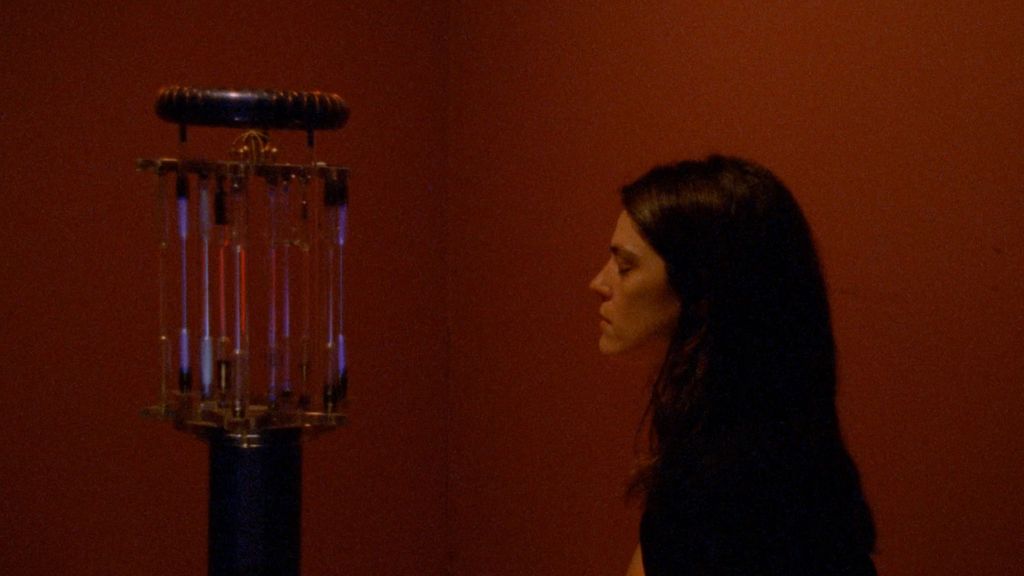
Radivojevic’s film is much more adventurous than Alfonso Cuarón’s highly-celebrated Y Tu Mamá También (2001). The latter’s lucidity is also why it’s a more affecting film—regardless, with Cuarón at Locarno to receive a Lifetime Achievement Award, the similarities between both films came into focus. Both are films about countries vanishing––Radivojevic’s about Yugoslavia and Cuarón’s about PRI-party Mexico. At Locarno, where so much stress is put on the future of cinema, this attachment to change and what it can offer was emphasized by Cuarón ahead of his special presentation of Alain Tanner’s Jonah who will be 25 in the year 2000 (1976).
During a Masterclass, he said that cinema will find its footing in the next generation. It was a bittersweet sentiment ahead of Tanner’s film, which concerns a group of disillusioned Swiss friends re-learning how to live according to the demands of normal society in the aftermath of May ‘68. The group of friends in the film is mostly depressed, but children bring them hope. Maybe Cuarón thinks of things similarly; Gravity (2013) afforded him the possibility to make Roma (2018), but that still means his Charlotte Gainsbourg vehicle—a passion project of his—fell through. Meanwhile, his native Mexico has suffered two major convulsions since Y Tu Mamá También: first, a hard-turn to the right under Presidents Vicente Fox and Felipe Calderón, and then a populist tailspin that’s ongoing. His hope for the future is admirable taking into account the series of bad experiences he’s had working in the film industry and the dismal, somehow worsening state of world politics; it’s worth remembering Cuarón’s son is also named Jonah. So, here’s to hoping the kids will be alright.
But, if there was any program that showcased the full potential of cinema at Locarno, and by that virtue demonstrated the poor state filmmaking finds itself in now, it was the special homage to Stan Brakhage that took place as part of this year’s edition of the “Histoire(s) du Cinema” sidebar. A “greatest hits” program—to quote the critic Erika Balsom, who introduced the screening—consisting of eight major films spanning the breadth of Brakhage’s career, this homage was unlike anything at the festival; that is, because there is no one like Brakhage. The shorts included in it, brief works of magic that combine formal experimentation with a distinctly human warmth, looked especially striking because they were new restorations, courtesy of archivist extraordinaire Mark Toscano. And yet, as one film gave way to another, more and more people left the screening. Perhaps such a radical way of filmmaking remains beyond the limits of an audience with a torpid imagination, one for which a sustained exposure to bad short films must be at fault. Hopefully, that will change.
